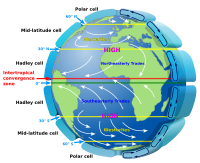
Photo from wikipedia
Using the Hybrid Single-Particle Lagrangian Integrated Trajectory (HYSPLIT) model, we tracked the paths of 46 autumn cold surges affecting North China from 1961 to 2014, and classified them by clustering… Click to show full abstract
Using the Hybrid Single-Particle Lagrangian Integrated Trajectory (HYSPLIT) model, we tracked the paths of 46 autumn cold surges affecting North China from 1961 to 2014, and classified them by clustering analysis, thereby investigating their changes and associated atmospheric circulation evolution. Our results indicate that autumn cold surges affecting North China can be classified into three types according to their paths: the north type, west type, and northwest type, with occurrences of 12, 16, and 18 respectively. Different types of cold surges have different atmospheric circulation characteristics. The north type is associated with a blocking type of atmospheric circulation pattern, with an enhanced stretching northeast ridge over the Ural Mountains and a transverse trough over Lake Baikal. However, the northwest type is characterized by a ridge–trough–ridge wave-train pattern that is located over the Barents Sea, West Siberian Plain, and Sakhalin Island, respectively. The west-type cold surge is related to a conversion type: a blocking system over the Ural Mountains forms four days before the cold surge occurrence, after which it becomes a wave-train type. The atmospheric signals detected prior to the occurrences of the three types of cold surges are also explored. The main signal of the north-path cold surges is that the energy propagates eastward from the Azores Islands to the Ural Mountains, and then forms a blocking high over the Urals. However, for the northwest-path cold surges, there is a weak trough over the Ural Mountains that gradually strengthens because the blocking high collapses over the Norwegian Sea. The key signal of the formation of the west-path cold surges is a blocking high over the Norwegian Sea’s continuous enhancement and extension to Novaya Zemlya, which results in a transmission of energy to the Ural Mountains and leads to the formation of a blocking system over here. When the above-mentioned different types of atmospheric circulation characteristics appear, the type of cold surge path and its impact area can be potentially forecasted in advance, which may reduce the losses that result from cold surges.
Journal Title: Atmosphere
Year Published: 2019
Link to full text (if available)
Share on Social Media: Sign Up to like & get
recommendations!